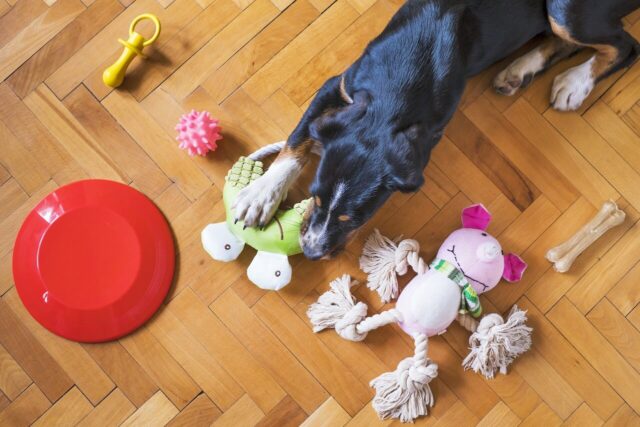Dog Toy Safety: Dos and Don’ts
Dogs love to play with toys! Playing with toys is beneficial for our dogs’ bodies and minds, but care must be taken as to what type of toys we select for our dogs for their safety.

Dog Toy Don’ts:
When considering what type of toys would be best for your dog or puppy, there are a few things to keep in mind for safety reasons:
1. Don’t use sticks as play toys. While a lot of dogs love to pick up any stick off the ground, actively using these as toys is never a good idea. They can and do break and splinter into smaller pieces. They can be accidentally swallowed or can get caught in the back of the dog’s throat. If a stick is swallowed, the sharp pieces can actually puncture the delicate lining of a dog’s intestines on the way out.
2. Don’t use tennis balls as toys. People love to use tennis balls with dogs, but unless your dog is less than 40 pounds, don’t do it. These balls are the worst thing for larger breeds, as they can easily get too far back into a dog’s throat. Unfortunately, they can’t be swallowed, but instead become trapped in the dog’s throat cutting off his air and killing him. You are better to use larger sized squeaky balls that have give in them or wiffle balls that have holes, which if accidentally lodged still allow air to pass through them.
3. Be careful about using exceptionally hard toys, especially with very small dogs or puppies with fragile teeth. Very hard objects can damage teeth through chipping or breaking them.
4. Always supervise your dog with his stuffed toys. Don’t put these toys in his crate or leave him unattended with them. Many dogs like to dissect their toys and rip out the stuffing. Every dog is different, and some dogs will pass the stuffing they eat. Others will develop a blockage and require emergency surgery.
5. Don’t use small plastic water bottles for toys. These are made of fairly brittle plastic that is easily flattened and broken. Pieces chip off and become sharp.
Dog Toy Dos:
There are many wonderful toy options available to you and your dog. Keep these things in mind as you select your dog’s toys:
1. Do provide your dog with age appropriate items. Many chew toys are not made for small breeds or for puppies under 6 months of age, so make sure to read all labels on any toys.
If your dog likes sticks, do select a toy that replicates it. There are several rubber ones available that are even shaped like a stick.
2. Buy no stuffing dog toys. If your dog likes to dissect toys, try some of the new stuffing-less toys so there is nothing to eat!
3. Make sure all toys are size-appropriate. Balls should be small enough to be picked up, but too large for any dog to accidentally swallow. If you notice that your dog can get a toy more than half way back in its mouth, this is a toy that is too small for it.
4. Do leave food stuffed Kong toys in crates or as unsupervised play toys instead of stuffed toys.
5. Try some of the more mentally stimulating toys for your dog. Toys that dispense food are excellent choices and can be used to provide your dog’s meal. Good examples include the Buster Cube, Tug a Jug, and the Atomic Treat Ball.
6. Focus on dog toy safety. If your dog likes the sound of water bottles crunching, instead of giving him the bottle, try a safer option by using one of the stuffed animal toys that slips a bottle inside. This way, your dog gets the crunch but avoids the actual bottle.
Any trip to a local pet store or shopping on-line shows how many choices there are in pet toys. If you are ever in doubt about the safety of an item, do a little on-line research or ask a store representative about the safety and your individual pet.
Always remember to supervise your dog with his toys and remove any that become damaged.
